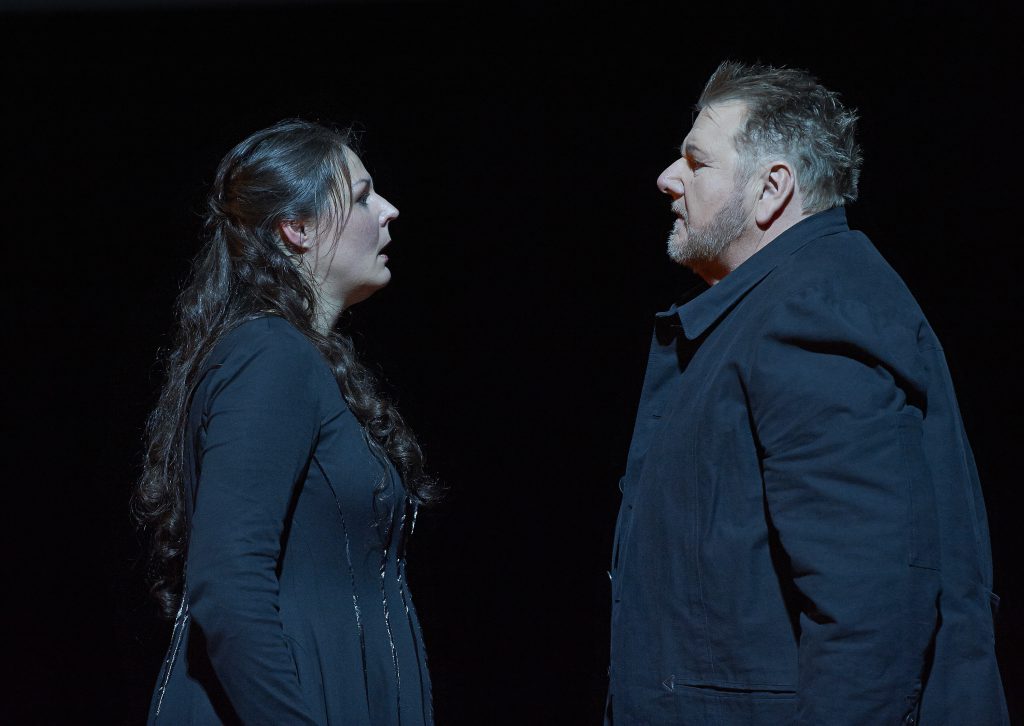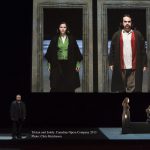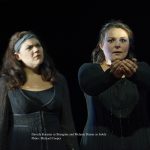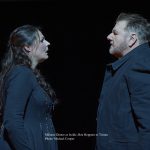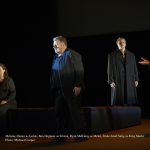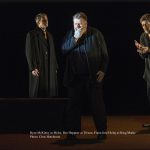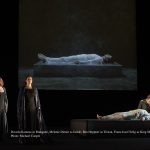The moment the first orchestra played the opening bars of Richard Wagner’s Tristan und Isolde, the world of opera forever changed. The legendary Act I Prelude with its revolutionary “Tristan chord”, balanced on the knife edge of atonality, heralded the birth of the contemporary musical world and with it twentieth century exponents like Arnold Schoenberg and Alban Berg. With Tristan, Wagner does not so much turn his back on the existing orchestral forms of his day, he vaults straight over them and lands squarely in the realm of modernity. We are in the land of chromaticism, the sounding together of unexpected notes, and interrupted cadences where themes are deliberately left hanging to create a sense of nervous tension. It is, for all intents and purposes, the same territory inhabited by an entirely new breed of composers who would invent the classic movie score. In fact, whole passages from Tristan und Isolde have been direct-quoted by film-makers from Buñuel to Hitchcock to Lars von Trier.
Wagner began writing his seminal piece in 1857, midway through work on the mighty Der Ring des Nibelungen cycle. The Tristan story pursued him off and on for the better part of a decade. The medieval legend of the ill-fated love triangle of king – princess – knight seemed to mirror his own obsession with Mathilde Wesendonck, the wife of his wealthy benefactor at the time. The alleged affair did not end well. Wagner lost lover, patron and his own wife Minna when the latter learned of her husband’s less than discrete liaison. It was not until his opera, judged unproduce-able by most promoters of the day, was finally presented to the public that Wagner was able to purge himself of the incident, at least creatively.
Premiering in Munich in 1865, Tristan und Isolde instantly provoked a storm of outrage. Not everyone eagerly embraced the composer’s notion of Gesamtkunstwerk (“total work of art”). With Tristan, Wagner brought to the stage a radical, highly personal vision of opera. Visual, musical and dramatic elements all were to serve the common interest of coherent artistic expression. Futurists championed the idea. Traditionalists scorned it.
With its much-anticipated restaging of director Peter Sellar’s 2005 Tristan und Isolde from Opéra national de Paris, the Canadian Opera Company works long and hard on stage to bring at least a small measure of closure to the still-simmering Wagnerian controversy. Towering musicianship. New age staging. The expected and the unexpected mingle and merge in this often astonishing creation of ambitious, if uneven proportions.
There is precious little physical action in this COC presentation. Indeed, it was never Wagner’s intention to present his telling of the Tristan tale as narrative pure and simple. One of the very few composers to write all his own libretti, Wagner’s self-admitted goal was to create a kind of symphonic song-poem, recrafting the story to emphasize its darker, more psychological side.
Tristan, knight to King Marke of Cornwall, sickened by the bloodshed he has been forced to commit in order to kidnap, Isolde, Marke’s chosen bride, shares the Irish princess’s wish for death. Bragäne, Isolde’s distraught handmaiden, desperate to save her mistress, secretly substitutes a love potion for poison. Warrior and princess fall victim to fierce enduring passion. Betrayed by his ambitious friend, Melot, Tristan and his cherished Isolde are discovered in each other’s arms. King Marke is horrified when his beloved champion is gravely wounded by Melot’s treacherous sword. Tristan flees to his ancestral castle where, dreaming of a love too impossibly precious to last, he dies before a grief-stricken Isolde can arrive to tend his wounds. Isolde takes her life in the belief that she will rejoin Tristan in eternity.
The psychic tapestry is as tangible as it is mythic. In this, the COC’s latest offering at Toronto’s Four Seasons Centre, projected backgrounds by American video artist Bill Viola take the place of conventional scenery. Elemental images of water/fire/earth/air, fade and dissolve, one into another, across an enormous screen suspended upstage. For the most part the poetic predominates in Viola’s mise en scène. Images can be riveting when camera and editing conspire. Row on row of flickering candles and lamps. Isolde’s ghostly avatar approaching through a shimmer of heat. A lifeless Tristan figure drawn slowly upwards through a waterfall. Striking, certainly, but averaged over the four plus hours of the production’s running time, moments when projection, music and singing converge tend to be hit and miss. At best, Sellars’ approach to staging is innovative and eye-catching. At worst, less compelling backgrounds frequently translate into little more than distracting sideshows in an already tumultuous operatic landscape.
With no sets, costumes or props to provide atmosphere and minimalist lighting design, video becomes the predominate visual influence driving this Tristan. With rare exception, characters pose austerely, statuesque and grounded, dwarfed by Viola’s projections, sombre punctuation marks to his unbroken stream of imagery. In this context, singer actor voices become voice overs to the virtual reality playing out on the screen behind them, a clever way, theoretically, to connect the cast to what is essentially a stand and deliver work. Perilous business this. The COC comes uncomfortably close to looming disaster. But opera is all about risk-taking and the undeniable brilliance of singing and playing on offer here snatches us from defeat.
Making his return to the legitimate Toronto opera stage after an absence of seventeen years, Wagnerian specialist Ben Heppner utterly soars as Tristan und Isolde’s brooding hero. Interestingly, Heppner, renowned for his mastery of the heldentenor repertoire, prefers to describe himself in interviews as a “large-voiced lyric tenor with overdrive”. It is, of course, this lyricism that gives his Tristan a unique tenderness and tragic humanity, a quality of voice that flows from the heart. Gone are all traces of the vocal frailty that plagued several local concert appearances in earlier years. His sound is strong, confident, embracing. An epic Tristan. But an accessible one with a big warm wrap-around sound.
With her unaffected style and transparent technique, German-born Melanie Diener appears as a wonderfully matched Isolde. Lighter and breezier than a typical Wagnerian soprano, her instrument is both crystalline in its sparkling clarity and resonant as a bell, clearly capable of undertaking any challenge however lofty and monumental, gentle and subdued. Her rendition of arguably the greatest single soprano aria in the entire Wagner canon, Liebestod (“love death”), the almost celestial cry for release from grief and sorrow that closes the last chapter in Isolde’s life and with it, the entire opera, is a moment to be cherished.
As Bragäne, Isolde’s anxious companion, Daveda Karanas gives a splendidly heartfelt portrayal of a woman stretched to the breaking point. Bass Franz-Josef Selig is a proud and mighty King Marke made powerless by the pain of Tristan’s death. Ryan McKinny and Alan Held sing Melot and Kurwenal, Tristan’s devoted retainer, respectively with compelling honesty and engagement.
COC Music Director Johannes Debus, conducting another milestone in his upward-bound career, leads an expanded group of one hundred plus players in a staggering performance of the colossal Tristan und Isolde score. The standard of musicianship is unsurpassed. Tempi are brisk but unhurried. Harmonies gorgeously developed. The opera’s three preludes perfectly rapturous. Spotting horns here and there on the upper level of the Four Seasons Centre’s spacious auditorium makes for an extraordinary surround sound experience during fanfares. Maestro Debus and orchestra continue to dazzle and delight. Their stamina is unflagging. Their playing beyond superlatives.
It is no coincidence that a major opera by Wagner, whose music inspired countless cinema soundtracks, should be produced as a kind of extension to curtain-to-curtain scenic video. What is surprising is that the approach retains as much of the original Tristan und Isolde zeitgeist as it does. Some operas are destined to exceed their own production in a sense. Tristan’s durability lies in the timeless glory of its music. The Canadian Opera Company has done well to centre its resources where it counts. There can likely never be a perfect Tristan. This one comes very close.

